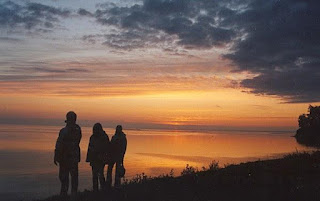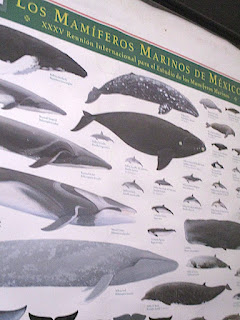Ever since I saw my first whales during an evening walk along the Saint Lawrence stream near Tadoussac, Quebec, whales fascinated me. I had driven friends from Europe to this small, but important town for whale watchers.
Hours before we had booked a tour for the next morning. But I wouldn’t participate in the boat ride out of fear of getting seasick in a small vessel.
However, I could enjoy the whales jumping in the river’s water in the evening silence - without entering a noisy and rocking boat. A local person told me the next day that this spectacle could be seen every night during morning dawn and evening dusk.
.
Cabo San Lucas, Baja California Sur
Twenty years later, on a sailboat during a sunset cruise around the impressive rocks of Cabo San Lucas, Baja California Sur, we were surrounded by eleven! Humpback Whales. They jumped, almost dolphin-like around the boat. The skipper was as surprised as we were. He mentioned the whale season is almost over in March.
.
Taking photos of these animals proved to be extremely difficult from the boat due to the waves and the movement of the whales. It seems to me they had fun jumping from one side of the boat to the other one.
The skipper stopped the boat to give us more time to watch the Humpback Whales. It seemed he enjoyed the spectacle as much as we did. It was already pitch-dark when we finally arrived at the Cabo harbor.
La Ventana
Spending time a couple of weeks every winter in La Ventana, Baja California Sur, between Cabo and La Paz, I can see whales at sunrise from my balcony with a binocular. La Ventana is a former fishing town on the Sea of Cortez, which is home to many types of whales, including blue whales, gray whales, whale sharks, and orcas.
.
Jacques Cousteau referred to the Sea of Cortez, separating Baja from the mainland, as “the world’s aquarium.” Containing almost 3,000 marine species, including 900 fish and a third of the world’s marine mammal species.
Types of Whales
Humpback Whales: They are migratory and visit the waters of Baja each winter and spring. Known to be very active and spry, they often delight with their acrobatic shows and lyrical songs. However, only males sing. They all sing the same song wherever they are in the world and the song gradually evolves and changes. Humpbacks are also known for being particularly acrobatic, leaping out of the water and slapping their huge fins and flukes.
Blue Whales: The upwelling currents around the islands, especially Cerralvo Island, in the Sea of Cortez provide nutrients for krill, which is blue whales' favorite food. It is the world's largest animal, reaching nearly 100 ft long and weighing 190 tons.
Gray whales: They are the most common whale in the Sea of Cortez, especially in the winter and spring and can grow to be 50 ft long and weigh 40 tons. Gray Whales are the only species that can easily enter shallow water.
Orcas: Also known as killer whales, these apex predators (top-level predators in a food chain that is not preyed upon by other predators) are black and white in color. You can see orcas in the Sea of Cortez, especially when there are mobulas (devil rays) around.
Fin Whales: They are the speediest whales in the world, swimming up to 25 miles per hour. in the Sea of Cortez you can witness a resident population of fin whales, thought to be a genetically isolated group.
Sperm Whales: The largest toothed whale, sperm whales dive to extraordinary depths and are known for fierce struggles with Architutheous, the giant squid. They hunt in the dark depths of the sea using echolocation, and following a deep dive, need to rest on the surface to re-oxygenate their blood. These whales are very distinctive on the surface with their “double blow”.
Minke Whales: At only about 25 feet long, minke whales are the smallest and one of the most abundant whale species worldwide. Seasonal visitors to the Sea of Cortez, they travel here to breed and birth from December through to April.
.
Whale Watching from La Paz, Baja California Sur
Whale watching regularly tops the bucket list for travelers. In La Paz, several whale-watching tours offer close encounters with the gentle sea giants, often combined with snorkeling and swimming, plus a lunch. It’s the lagoons on the Pacific coast that provide the most spectacular draw, as they fill up with thousands of grey whales each year – a species so friendly they regularly approach boats and introduce their enormous babies to the wide-eyed onlookers onboard.
Virtually every grey whale on Earth swims here to mate and give birth between February and March, clustering in sheltered lagoons. But this is no ordinary whale watching experience; the greys are known as “the friendly whale” and appear to see out boats to play with, meaning this is one of the most up close and personal whale encounters in the world.
.
Dozens of islands and islets lie scattered between La Paz and Loreto in the tranquil Sea of Cortez, and one of the best ways to explore them is in a kayak. Multi-day kayaking trips take you from island to rocky island, with the opportunity to stretch your legs by trekking across the dunes or cool off with a snorkel. Sea lions and pelicans frolic on the islands, while dolphins leap offshore.
Museo de la Ballena in La Paz
I finally made it this winter to the Whale Museum. Instead of waiting for a “Collectivo”, I walked the 8 blocks from the Malecon, but it also would have cost me only 80 cents, or 3 dollars with a taxi.
The friendly staff gave me a quick introduction in English about the artifacts, the whale skeletons, and the historical evolution of the whale species. Usually, there are Spanish tours, and English only at certain times and days. However, all the guides I met and asked questions spoke decent English.
The entire museum __ which can be fully explored within an hour or two __ includes five exhibition spaces with life-size models and skeletons of marine animals, educational videos and audio soundtracks, and information about marine life conservation. Some exhibits also show how dangerous sea mammals and turtles are living and how fishing nets and plastic debris endanger their lives.
A tourist favorite, the Whale Museum is busiest during the whale watching season, which runs typically from January to March. From Tuesday to Friday, especially in the mornings, it is quiet there, and you can ask the knowledgeable guides, mostly young marine biology students all your questions.
On this Expedia website are some spectacular and professional photos of the museum’s exhibits (way better than my own : )
https://www.expedia.com/Whale-Museum-La-Paz.d6269586.Vacation-Attraction?gallery-dialog=gallery-open
.
The partially open-air Museum’s hours are Tuesday to Sunday, 9 a.m. - 2 p.m.
Address: Antonio Navarro 855, Zona Central
entre Altamirano y Gómez
Be aware there are still articles on Google that show the former museum exhibition place on the Malecon! They moved a couple of years ago to Zone Central.
Website in Spanish: https://www.museodelaballena.org/
https://www.instagram.com/museodelaballena/
.
<><><><><>
.



.jpg)











No comments:
Post a Comment